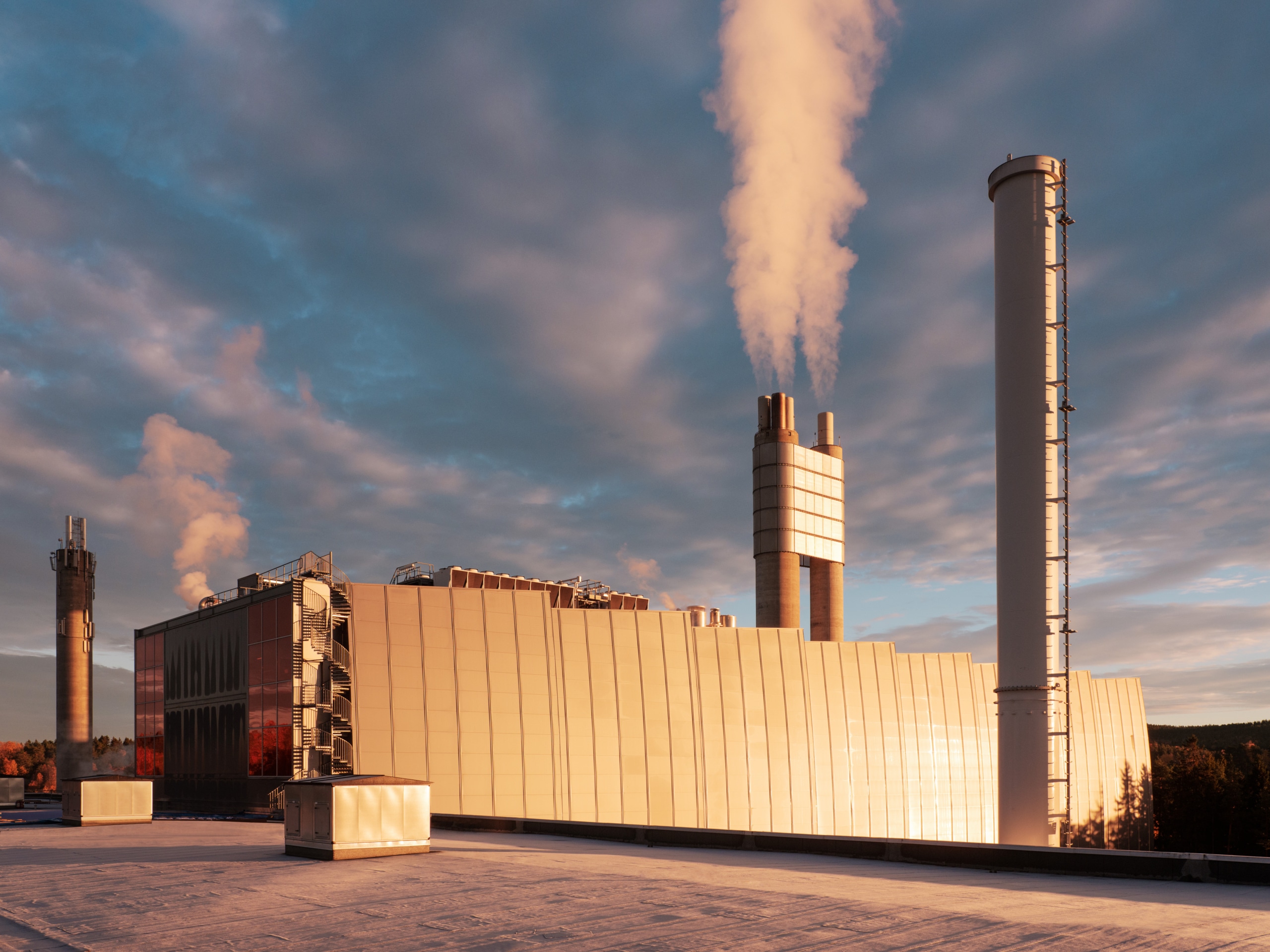
District heating and cooling: Hafslund Oslo Celsio
A word from the Managing Director
2023 was an eventful and turbulent year for Celsio.
The company has undergone a major period of change in recent years. Under the new owners, after having been part of the Fortum Group, we have carried out a significant restructuring process and are now standing firmly on our own two feet. We have strengthened our position both in terms of organisation and technology. Day-to-day operations proceeded as normal during the period in which all these changes were being implemented, and several major development and construction projects have progressed well.
At the same time, external factors have contributed to challenges on several fronts. The framework conditions that we are obligated to operate under, such as the electricity compensation scheme, have hit the company hard and had a significant negative impact on the bottom line. The waste incineration tax that was sharply increased at the beginning of 2024 also has a major impact. There is still uncertainty associated with the future price model for district heating while a decision from the government authorities on a proposal for a new model is still pending. With such uncertain framework conditions, it is challenging to lead a capital-intensive energy and infrastructure company like Hafslund Oslo Celsio, and make recommendations for future investments.
We are working hard to get the government authorities to understand the critical role we play for society and there is a serious need for more district heating, which was something the Energy Commission highlighted in its report. The Energy Commission identified the potential to relieve the burden on the power system and the grid by 2-4 TWh if there is a commitment to district heating. This would provide major savings to society in the form of lower energy and grid development costs and also provide a more robust energy system. However, district heating and new climate technology such as carbon capture do not build themselves, and they will not be built if the framework conditions do not allow the sector to have financial sustainability and stable prerequisites that enable new investment decisions to be made. We worked intensively in 2023 to highlight the need for a holistic improvement in the district heating industry’s framework conditions and will continue this important work in 2024.
Price rises caused by inflation, geopolitical instability and a weaker Norwegian krone contributed to us moving the carbon capture project at Klemetsrud into a cost-reducing phase in April. This was a setback, but it is also correct and important to control costs and ensure that the project is sustainable. The work on advancing the project towards a new investment decision in 2024 is progressing well.
We experienced a tough year financially, but stood firm together. We have a lot to be proud of. The company is now in better shape than it has been for a long time, and we stand strong as Norway’s leading circular energy company.
I have rolled up my sleeves and am ready for a tough but exciting 2024.
Knut Inderhaug

Important events for the district heating business in 2023
Description of the business area
Hafslund Oslo Celsio supplies the residents of Oslo with heating and cooling. Among other things, district heating is produced by utilising excess heat from the city’s waste incineration, data centres and sewage. Hafslund Oslo Celsio owns and operates two waste incineration plants in Oslo and ensures sustainable handling of waste that cannot be recycled. Hafslund Oslo Celsio is also working to realise full-scale carbon capture and storage at the Klemetsrud waste incineration plant.
In addition to being an energy supplier, Hafslund Oslo Celsio is an infrastructure and urban development company that contributes to the development of a greener and smarter Oslo. Hafslund Oslo Celsio also owns 100 per cent of the fibre company Hafslund Fiber, which provides dark fibre in the Oslo area. At the end of 2023, Hafslund Oslo Celsio had approximately 238 employees working at the two waste incineration plants at Klemetsrud and Haraldrud and at the headquarters in Skøyen.
Waste incineration
Hafslund Oslo Celsio owns and operates two waste incineration plants, one of which is located at Klemetsrud and the other at Haraldrud in Oslo. From these plants, the company provides safe and environmentally friendly final treatment of residual waste that cannot or should not be recycled. Hafslund Oslo Celsio incinerated a total of 366,000 tonnes of residual waste in 2023. The excess heat produced from waste incineration is fed into the district heating network.
District heating activities and waste incineration are important and necessary parts of the circular economy. Incineration of this type of waste has a much lower impact on the environment than storing waste in landfill, which is still a common practice in many European countries. The CO₂ emissions emitted by one tonne of waste over the lifetime of the landfill are about 50 per cent higher than the CO₂ emissions emitted from the incineration of one tonne of waste. Incinerating the waste and utilising the energy that is created also reduces society’s need for electricity, and relieves pressure on the rest of the energy system.
Heating
Hafslund Oslo Celsio produces, distributes and sells district heating. The production of district heating is largely based on excess heat from the company’s waste incineration plant, however also includes excess heat from data centres and Oslo’s sewage. Other energy carriers such as bio-oil, electricity and wood pellets are also used during peak-load periods.
Heat production supplied to the district heating network was 1,997 GWh in 2023. Of this total production, 1,014 GWh was from waste heat (excess heat from the incineration of sorted residual waste), 218 GWh was from heat pumps, 208 GWh was from wood pellets, 389 GWh was from electric boilers, 136 GWh was from bio-oil, and 32 GWh was from liquefied natural gas (LNG). Hafslund Oslo Celsio’s share of fossil fuels was therefore 1.7 per cent in 2023. At Klemetsrud, 150 GWh of electricity was also produced using excess heat from waste incineration.
Hafslund Oslo Celsio is actively working to increase the use of local excess energy as sources of heat for district heating production. STACK’s data centre at Ulven now transfers around 5.0 MW of thermal energy to Hafslund Oslo Celsio’s district heating system. This provides heat equivalent to heating and hot tap water for 4,000 Oslo homes, and reduces Celsio’s need for an alternative supply of energy by 22 GWh.
Cooling
It is Hafslund Oslo Celsio’s plan in the coming years to offer its commercial customers a total thermal energy solution, which is something that requires the company to be able to supply both district heating and cooling. Hafslund Oslo Celsio currently supplies some customers with district cooling via a partner’s district cooling centre. The company is also working to establish its own district cooling centres, which will produce district cooling by collecting cold water from the Oslo Fjord and/or by using large heat pumps.
Hafslund Oslo Celsio has thus far identified three areas for commercial growth in Oslo as being the most important market areas for district cooling: City-centre (within Ring 1, including Filipstad), Skøyen and Ulven/Økern. The commercial building Construction City is currently under construction at Ulven/Økern. Through the company Hovinbyen Energy Hub, which Hafslund Oslo Celsio owns together with housing developer OBOS, a new district cooling centre will be established to supply district cooling to the commercial buildings in the Ulven/Økern area.
The district cooling centre at the new Oslo Emergency Ward was completed and brought online in November.
District cooling is an important part of future urban development. When buildings with their own cooling systems are converted to district cooling, roof areas can be freed up for technical installations and used for other purposes, such as living areas and management of urban runoff. Areas inside buildings that were initially used to house energy systems can also be freed up.
For the city of Oslo, district cooling will make a positive contribution towards infrastructure development and result in lower greenhouse gas emissions. When there is no longer a need for each building to have its own cooling production or energy wells, underground areas can be freed up for other infrastructure, for example, tunnels for public transport. District cooling will also contribute towards phasing out the use of hazardous hydrofluorocarbons (HFCs) in Oslo, in accordance with the climate plan for 2021-2030.
Carbon capture and storage
Hafslund Oslo Celsio’s waste incineration plant at Klemetsrud is Oslo’s largest emission point and produces a significant proportion of the city’s total CO₂ emissions. Without carbon capture at the plant, it will not be possible for the City of Oslo to achieve its ambitious climate targets. The agreement to finance a full-scale carbon capture and storage plant at Klemetsrud was entered into in June 2022 and construction work commenced in August 2022. However, in April 2023 Hafslund Oslo Celsio made the decision to move the project into a cost-reducing phase. Updated estimates showed that sharp price increases for equipment deliveries due to inflation, geopolitical instability and a weaker Norwegian krone would cause the project to exceed the investment framework. At that point in time, the project had used less than ten per cent of the investment framework. As part of the cost-reducing phase, new suppliers were asked to present alternative solutions that could reduce costs. In November, on the basis of concept studies that were carried out, Aker Carbon Capture and Aker Solutions were selected to conduct the engineering and design phase of the project, with the possibility of a contract for the construction and installation of the facility. At the same time, Hafslund Oslo Celsio chose to cancel the agreement with the original supplier.
Throughout 2023, the company had constructive dialogue with stakeholders such as the Ministry of Petroleum and Energy, Gassnova, the City of Oslo and owners regarding how Hafslund Oslo Celsio can best realise a sustainable carbon capture project.
Aker’s preliminary study with a new concept for the carbon capture plant will be ready by summer 2024. Hafslund Oslo Celsio has a clear ambition of establishing carbon capture at Klemetsrud. Carbon capture as part of responsible waste management is strategically important for the climate, for Norway, for Oslo and for Hafslund Oslo Celsio. The goal is to make a new investment decision for the project in the summer of 2024.
Hafslund Fiber
Hafslund Oslo Celsio owns 100 per cent of the fibre company Hafslund Fiber, which is a leading player within dark fibre in the Oslo area. Hafslund Fiber is building the next generation fibre network in and around Greater Oslo, and is an operator-neutral infrastructure partner. When Hafslund Oslo Celsio lays district heating pipes to expand the district heating grid, Hafslund Fiber simultaneously lays conduits for fibre beside the district heating infrastructure.

Statement of value creation
| NOK million | 2023 | 2022 |
|---|---|---|
| Sales revenue | 2,738 | 1,707 |
| Other gain/loss | 307 | -247 |
| Other operating revenue | 27 | 19 |
| Revenues and other income | 3,072 | 1,479 |
| Energy purchases and transmission | -1,251 | -647 |
| Salary and other personnel costs | -302 | -151 |
| Property tax and other imposed costs and compensation | -5 | 6 |
| Other operating costs | -729 | -293 |
| Profit/loss from equity-accounted investees | - | - |
| EBITDA | 785 | 394 |
| Depreciation and amortisation | -595 | -232 |
| Operating profit (EBIT) | 190 | 162 |
| Net financial items | -291 | -148 |
| Profit before tax | -102 | 14 |
| Income taxes | 39 | -1 |
| Profit after tax | -62 | 13 |
*) Hafslund Oslo Celsio became part of the Hafslund Group on 19 May 2022 and the figures for 2023 are therefore not comparable to figures for 2022.
2023 was a particularly demanding year for the district heating business. The sales volume has been high with 1.8 TWh. However, the profit after tax ended at NOK -62 million in 2023. Framework conditions, price increases on fuels and extraordinary costs had a negative impact on the result.
The business area had total operating revenues of NOK 3,072 million. This primarily related to revenues from district heating.* Despite high sales volumes (11 per cent higher compared to 2022), revenues from underlying operations were not correspondingly high. The district heating price is tied to the electricity price, which was significantly lower in 2023 than in 2022. The district heating prices are also limited by the electricity support scheme, but unlike electricity companies, the district heating operators have not received compensation from the Norwegian State for the lost income this has caused. During the winter months, the price of the input factors is significantly higher than the revenue cap set through the electricity support scheme, and this alone reduced revenues by NOK 227 million in 2023.
Operating costs were impacted by high fuel prices in 2023. At the same time, fixed costs were higher than normal as a result of restructuring and new IT infrastructure, increased maintenance costs and cost-entries associated with the carbon capture project (CCS). The latter applies to ongoing measures to reduce project costs and ensure that the project is profitable.
Write-downs of book values linked to CCS and the “Klemetsrud – Line 4” project totalled NOK 188 million.
Net financial costs amounted to NOK 291 million, and increased as a result of higher average interest rates. A loan of NOK 500 million was taken out in mid-2022.
* Operating revenues also include “Other gains/losses” which, at NOK 307 million, were significant. Much of this gain relates to the correction of hedging accounting from 2022 and was not a result of underlying operations. For further information, see Note 5.6 to the consolidated accounts.


